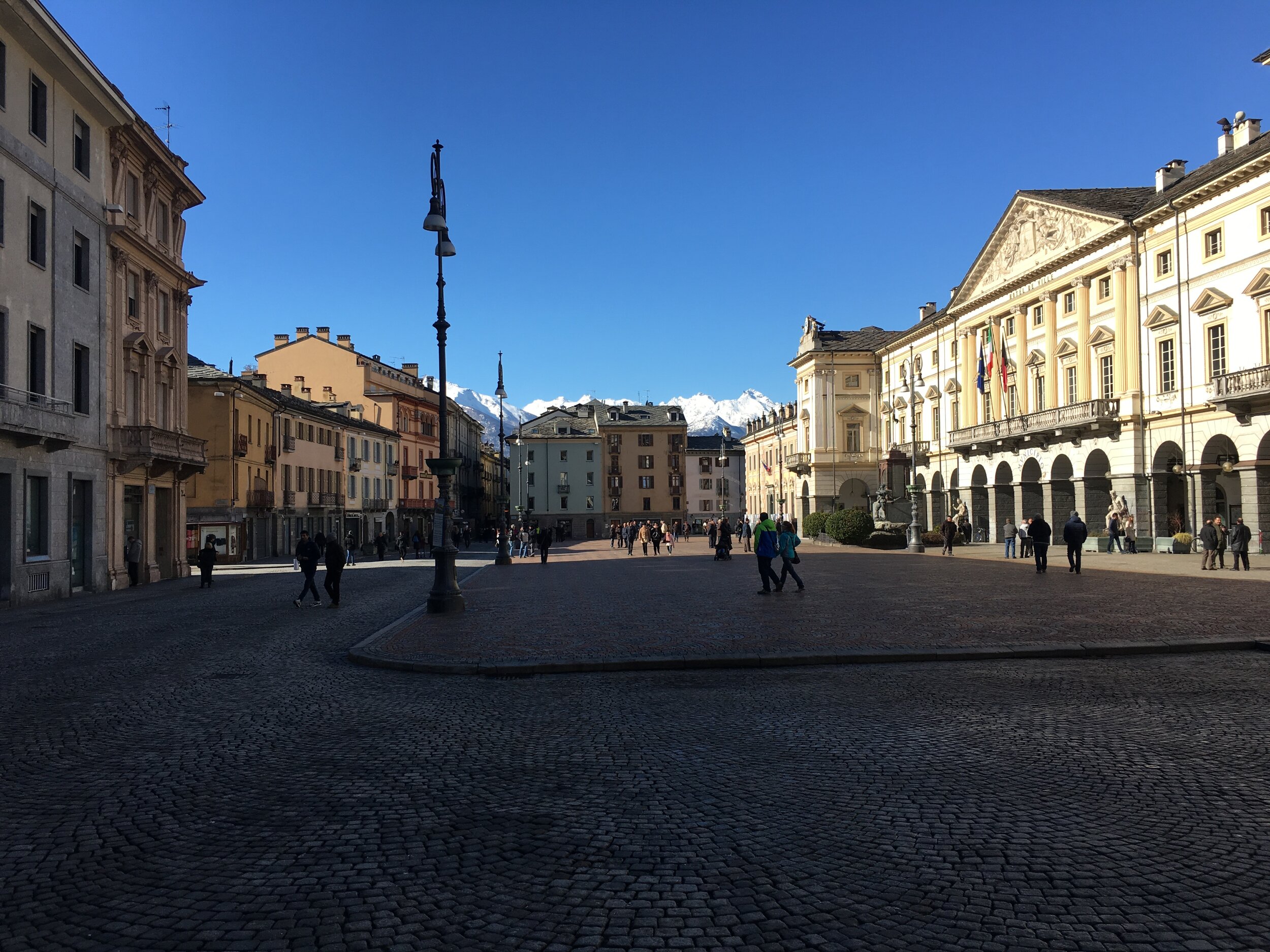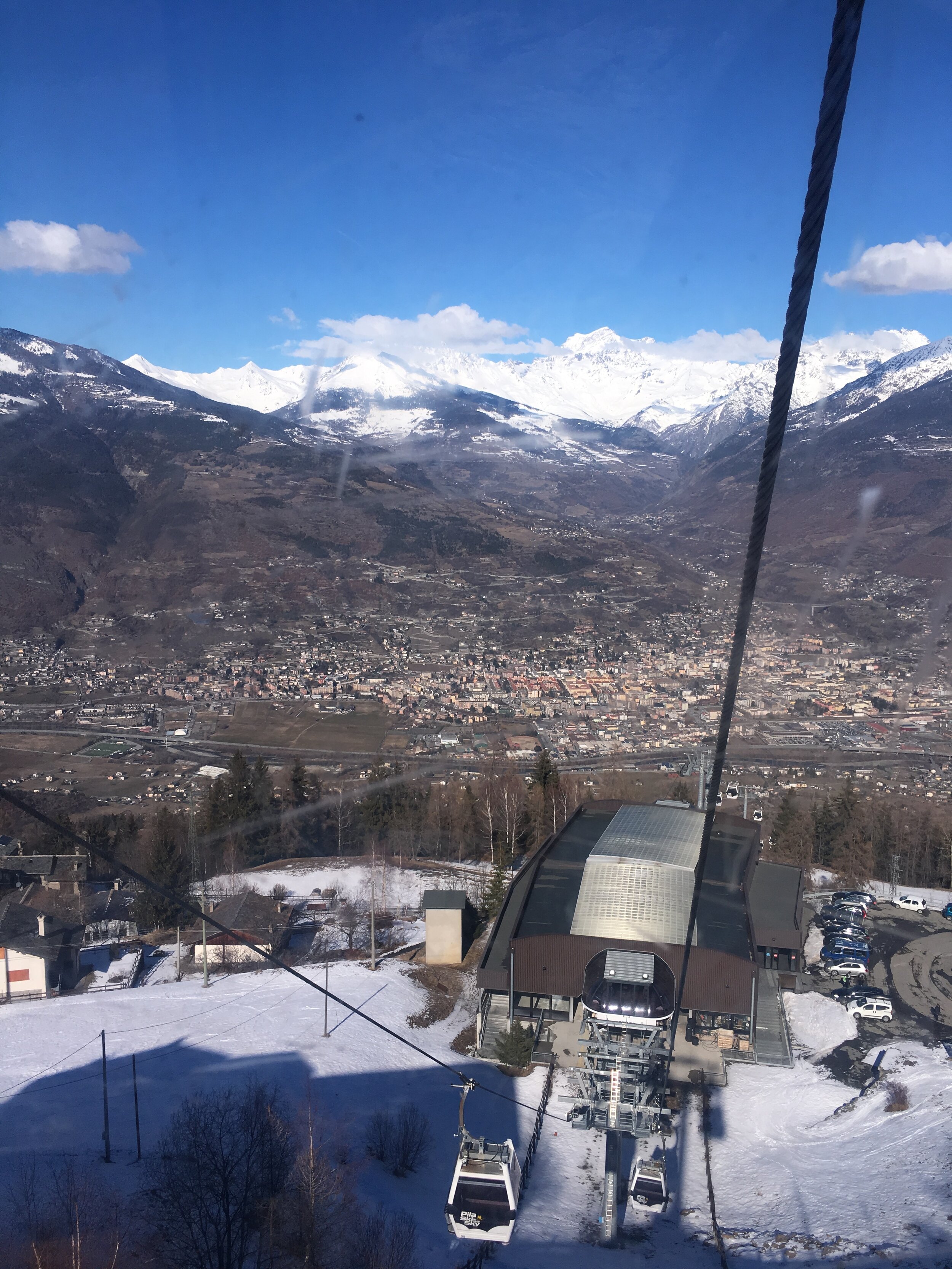Introduction to the city of Aosta
The town of Aosta is small, but it is the capital city. In fact, it has earned the epithet of “Rome of the Alps.” This honor certainly piqued my interest as an incurable lover of Rome, and Aosta did not disappoint.
Aosta rests at the base of the Alps. While rambling around the enchanting town, I found this quite comforting. The Alps almost envelop the city; indeed, you feel the sensation of being in a valley. While walking down the characteristically Alpine village streets, you can see the surrounding mountains from many angles. If I put on my ‘Romantic literature scholar’ hat, I turn to the concept of the sublime. It is perhaps nowhere better expressed than in Percy Bysshe Shelley’s poem “Mont Blanc: Lines Written in the Vale of Chamouni.” I channeled the sensation of the sublime by taking the cable car up close to the impressive Mont Blanc. Thankfully, I had the cable car to myself so I could read these lines aloud and feel the true power of their articulation; though tell me who would not appreciate these mighty lines from stanza three read in the presence of the sublime subject:
Far, far above, piercing the infinite sky,
Mont Blanc appears—still, snowy, and serene;
Its subject mountains their unearthly forms
Pile around it, ice and rock; broad vales between
Of frozen floods, unfathomable deeps,
Blue as the overhanging heaven, that spread
And wind among the accumulated steeps;
I truly embraced my Romantic ‘fangirldom’ and read Shelley’s poem while gazing at the peak of the mountain. The sublime refers to a sensation of feeling overpowered by the grandeur and majesty of nature; this feeling even takes on somewhat negative connotations, almost a sense of ‘terror’ at the beauty of nature. It is a complex concept, but gazing at Mont Blanc, so tall the summit is often covered by clouds, is a sure way to rouse these complicated feelings, a way to reflect on human mortality and the environment. The Romantic mountain stands in France, but this region in Italy is at the confluence of three countries and their Alps—Italy, of course, France and Switzerland.
The Pila ski resort is very close to the center of Aosta, located just above it, in fact (read more in the regional features section). In fact, I walked over to the base of the cable car in only 15 minutes. I walked through many open parking lots to reach the departure point; therefore, for those actually engaging in a ski vacation, the area seems quite convenient even if you wanted to stay in Aosta and travel up to ski each day.
Aosta was originally settled by the Salassi people, an early Celtic tribe, but around 25 BCE Caesar Augusts (also known as Octavian) conquered the area and founded the Roman town of Augusta Praetoria Salassorum, our present day Aosta. These original settlers, the Celtic people, are also known as ‘Gauls’ because the large area they inhabited spanning France, Luxembourg, Belgium, most of Switzerland, and parts of Northern Italy, Netherlands, and Germany was known as ‘Gaul’. Aosta is a reference to the great emperor Augustus; thus, the region became the “Valley of Augustus” as he used advantageous geography to build strategic bridges and roads through the mountains nearby.
Today, the Roman legacy is visible throughout the small town, and another indispensable piece of Roman history is the Arch of Augustus, dedicated to the emperor and created at the same time to commemorate his victory over the Salassi. It is free standing in the city and free to access. Another free Roman era monument that is integrated into the fabric of the city is the Praetorian gate. It was created as the Eastern access point to the Roman town and has been there since the foundation in 25 BCE. Even the origin of the name connects to Roman times. However, the most impressive and extensive Roman monuments are found in the Roman theatre. You do need to pay to access this site, but with your 7 euro ticket, you can also visit the Cryptoporticus and the Archeological Museum. I would recommend visiting all of them, and I will share more about each of them in the spots post.


